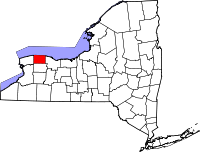Orleans County, New York
| Orleans County, New York | ||
|---|---|---|

County courthouse and clerk's office in Albion
|
||
|
||
 Location in the U.S. state of New York |
||
 New York's location in the U.S. |
||
| Founded | 1824 | |
| Named for | House of Orléans | |
| Seat | Albion | |
| Largest town | Albion | |
| Area | ||
| • Total | 817 sq mi (2,116 km2) | |
| • Land | 391 sq mi (1,013 km2) | |
| • Water | 426 sq mi (1,103 km2), 52% | |
| Population | ||
| • (2010) | 42,883 | |
| • Density | 110/sq mi (42/km²) | |
| Congressional district | 27th | |
| Time zone | Eastern: UTC-5/-4 | |
| Website | www |
|
Orleans County is a county in the U.S. state of New York. As of the 2010 census, the population was 42,883. The county seat is Albion. The name is in honor of the French Royal House of Orleans.
Orleans County is part of the Rochester, NY Metropolitan Statistical Area.
When counties were established in New York State in 1683, the present Orleans County was part of Albany County. This was an enormous county, including the northern part of New York State as well as all of the present State of Vermont and, in theory, extending westward to the Pacific Ocean. This county was reduced in size on July 3, 1766 by the creation of Cumberland County, and further on March 16, 1770 by the creation of Gloucester County, both containing territory now in Vermont.
On March 12, 1772, what was left of Albany County was split into three parts, one remaining under the name Albany County. One of the other pieces, Tryon County, contained the western portion (and thus, since no western boundary was specified, theoretically still extended west to the Pacific). The eastern boundary of Tryon County was approximately five miles west of the present city of Schenectady, and the county included the western part of the Adirondack Mountains and the area west of the West Branch of the Delaware River. The area then designated as Tryon County now includes 37 counties of New York State. The county was named for William Tryon, colonial governor of New York.
...
Wikipedia

